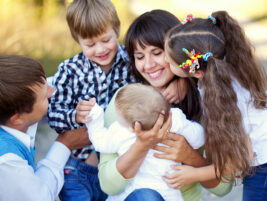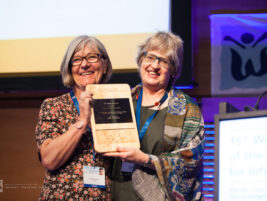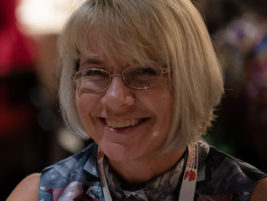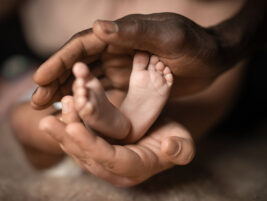We have learned from various studies, including Charlie Zeanah’s, how detrimental the institutional environment is for the parentless infant’s bio-psycho-social development. We also know that after the age of 24 months, the institutionalized infant’s developmental prognosis is significantly worse than that of an infant who has been adopted before 24 months of age. We can also observe after 24 months the long term sequelae of the lack of attachment figures – a point of “no return”:
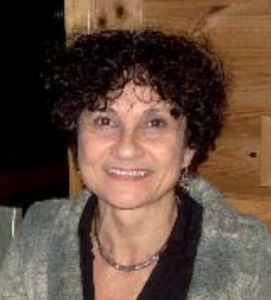
Three years ago, I was asked by the Social Welfare Head to take the position of consultant child psychiatrist of the Baby Home in the Tel Aviv area (Israel). With the knowledge I had about parentless infants and institutional environments, I wondered very much about my role. During the first year, I had a very frustrating experience, similar to the one described by our Greek colleague, Grigoris Abatzoglou, while listening to the comment made by every one involved in directing the Baby Home. “You can’t expect an institution to function like a home. We are doing our best, and you have to accept the situation as it is here. This is not the university where you teach!” I was left alone with my academic knowledge and clinical experience, helpless in front of the infants who appeared doomed to add to the gloomy data about institutionalized young children.
Life events, as we all know, can change the path of development. It seems to me this is also true regarding our professional development. Anna Tardos (in this Issue) has eloquently described how Emmi Pikler’s own resilence and creativity helped her survive WW II, and then led her to create the Loczy home for the post-war abandoned babies. Myriam David, who created the Loczy Institute in Paris after having survived a Nazi camp, once told at a WAIMH Congress, the personal meaning of the Piklerian approach for her. To her, it had restored respect for humans, respect that she thought,had been destroyed forever.
Let me tell you about the small personal life event that made me find a way out of the professional impasse I was facing at our Tel Aviv Baby Home. Two of my own children decided to do their medical studies in Budapest, Hungary, at the International Studies of the University of Simmelweiss. As a “good enough ” Mum, I had to go there and be sure they had all that they needed, forgetting they were already adults, but also remembering what Bernard Golse had told me, a year before (at a symposium on adoption) about a unique institution for infants, called Loczy, in Budapest. I called him in Paris and asked him whether I could go and see the place. It turned out they were planning to organize a training week for advanced professionals who already knew the Piklerian approach. Though I was a complete novice in that specific field, they agreed to take me in. I was honored and timid. On the first day, I was introduced to the main concept of “respecting the baby.” Until then, I thought I knew what it meant to respect a baby. What I learned was how to convey respect to the baby, which concrete gestures and attitudes demonstrate. This issue of the Signal summarizes the main points of the Piklerian developmental approach to babies in general and how to apply it in potentially detrimental environments such as institutions for abandoned babies.
What was even more special to me during that week long workshop was learning about the concrete meaning of respecting the infant’s future adoptive parents. The first day of the workshop was about ways to transmit the main tenets of the Piklerian approach to the new nurses at Loczy. We were watching tapes (those mentioned by Anna Tardos in her paper), and I felt somehow bothered by what looked to me artificial in the way nurses were so well trained in doing the exact Piklerian movements and talk while caring for the infants. I was struck by the lack of the common, spontaneous behaviors caregivers usually display with infants, such as kissing. I did not dare saying anything, but Julianna Vamos, an extremely sensitive clinician and one of the leaders of the workshop, saw my nonverbal cues and asked me to express overtly my feelings, which I did, thanks to the facilitating environment of that workshop. Dr. Vamos explained how their way of caregiving reflects the therapeutic aspect of the Institution, similar to the psychodynamic and therapeutic setting. She went on to say, “We are therapists, not parents or friends or relatives. The institution cannot be, by definition, a regular home, therefore we cannot behave ‘as if we are parents’, we can only be good enough caregivers and clinicians. The caregiving interaction between the nurse and the infant is a psychotherapeutic one, not a parent-infant relationship.” Therefore the nurse needs to be taught not to be overwhelmed by her countertransferential urges to kiss the infant as if he is her own or to maltreat him because he is a “difficult” baby as we can see in many institutions. “You see, you can tell the infant about the special kiss that can be given only by two persons in the world: his adoptive parents who will, one day, come and take him home…and meanwhile, you just touch him affectionately and respectfully of his own desir.e” It took me a full week to comprehend, feel, and internalize this sentence, but since then, this is what I have been teaching the team of our own Baby Home in Tel Aviv. In the process of making the notion of respect more tangible, we have started to look at body caregiving interactions with the team. Talking to the infant, identifying his strengths and weaknesses, developing Insightfulness (see the Book review in this Issue) and verbalizing the countertransferential feelings he evokes in the team, have become part of the routine activities. This process requires the mental health consulting team be very patient and tolerant of the team’s difficulty in making changes, to speak a new “language,” to become professionals and not just caretakers. In my experience, this is a hard mountain to climb…but the scene you may see when you’re only half way to the top is already worthy: it is a better world for those infants who are at the utmost risk of developing long lasting psychopathology.
Authors
Keren, Miri, M.D.,
the Editor of Signal,
Israel



